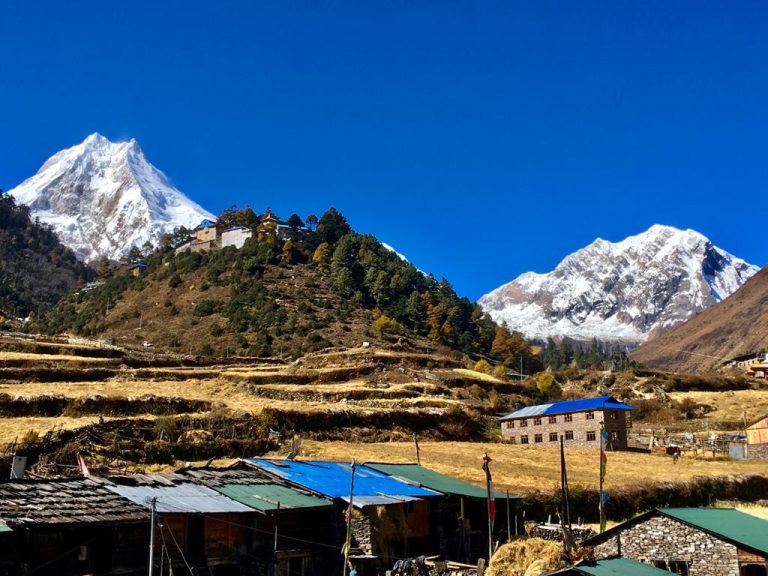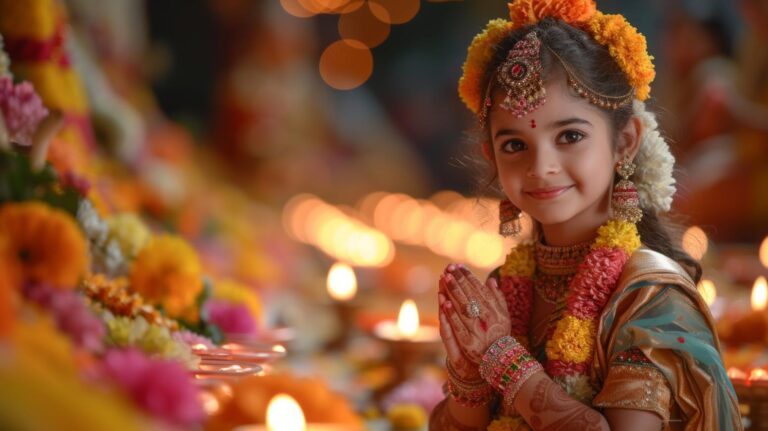
Nepal is a land rich with stories, but one of the most fascinating is the tale of the Kumari, the Living Goddess. Goddess Kumari is said to be the manifestation of Goddess Taleju with the added power of Kali. This extraordinary tradition is taken very highly by Hinduism and Buddhism in a very unique way.
The word “Kumari” means “virgin”. A girl is picked from families with a special background and has to be very brave and pure. When she’s chosen, she lives in a beautiful palace and does important religious things. People celebrate with her during special festivals. When she starts to mature or experiences any kind of bleeding, it is thought that the goddess leaves her body. And another girl takes her place.
It is a long-standing custom that shows how much people respect and honor goddesses. This ancient practice, dating back to the 17th century, is a fascinating glimpse into Nepal’s cultural and spiritual heart.
Table of Contents
History of the Living Goddess Kumari
Among the many legends that go around, there are a few that seem more convincing regarding the origin of Goddess Kumari. Jaya Prakash Malla, the last King of the Malla Dynasty, is said to have come across Goddess Taleju who visited his chambers as a beautiful woman during night time. The goddess promised to visit the King every night to play Tripasa (a game that involves dice) if he keeps the secret meetings to himself.
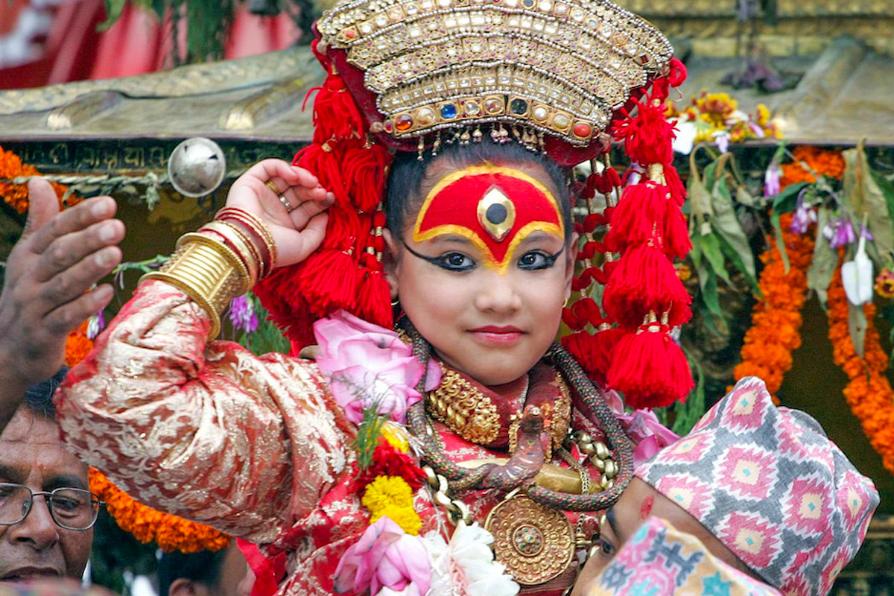
However, the King’s wife was suspicious. One evening, she happened to follow him to the chambers with the intention of inspecting what exactly was going on with her King. Goddess Taleju became aware of this and left in anger. The goddess, however, paid a visit to the King after this event in his dream. Goddess Taleju told King Jaya Prakash Malla that she would reincarnate as a living goddess that would possess children from the Newar community, specifically, Shakya and Bajracharya community.
The King then commenced the search for the special child with Goddess Taleju’s spirit. This is how the tradition of the Kumari Goddess is known to have been started. A house was also built for the accommodation and looking after the Kumari. The house was named “Kumari Ghar”, which at present time, is among the popular sacred destinations in Kathmandu.
There are many such Kumari in Nepal at present. Most Newari communities have a ‘Kumari’ but the Royal Kumari is the most senior. Even the Royal family of Nepal used to take blessings from the Royal Kumari during the Monarchy in Nepal.
Selection of Kumari – The Living Goddess
There is a national search for the Kumari once the present Kumari loses the title and power of being a vessel for Goddess Taleju. The selection process includes criteria which are made sure to be met by a council composed of Senior Buddhist Bajracharya, Chief Royal Priest, Priest of Taleju and Royal Astrologer. There are 32 such criteria that are known as ‘perfections’ of a goddess, some of which are:
- Eyelashes like those of a Cow
- Chest like a lion
- Body like a Banyan Tree
- Voice soft and clear as of a duck
- Same horoscope as of the King
- Thighs like those of a deer
- Very black hair and eyes
If you thought it is that simple, let us assure you that it is definitely not.
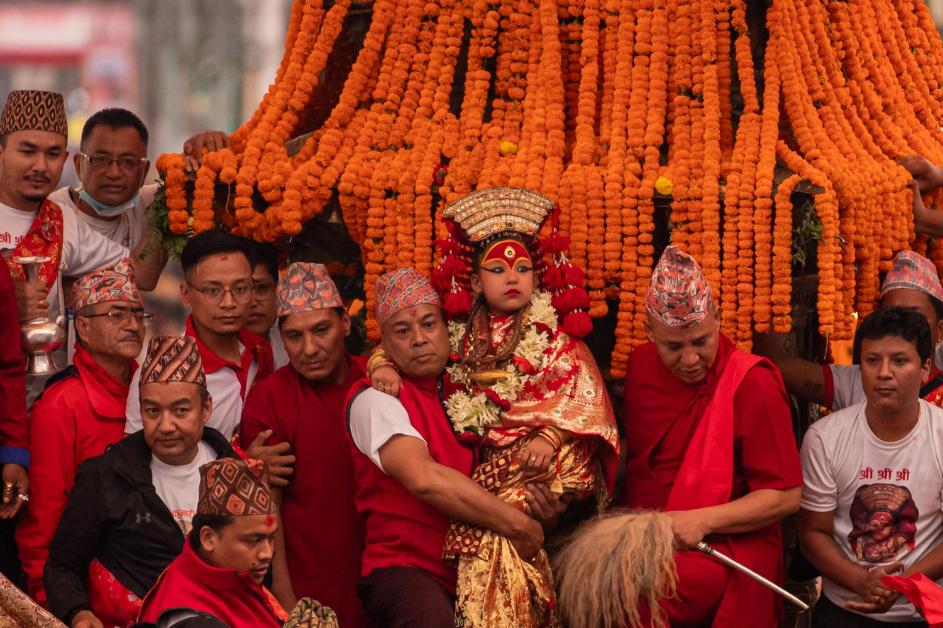
This special test is performed during the Kalratri (9 Black Nights) of Dashain, the most important festival. For the final selection of Kumari, she has to spend a night with 108 heads of buffaloes and goats that are sacrificed to goddess Kali. They are kept in a room lit by candles, along with a few masked men who make scary noises and watch to see if the girl is scared.
She also has to search for the belongings of the ex-Kumari in the same room. If she passes this test, she will be known as the new Living Goddess Kumari in Nepal. If she fails, another girl is chosen to take the same test.
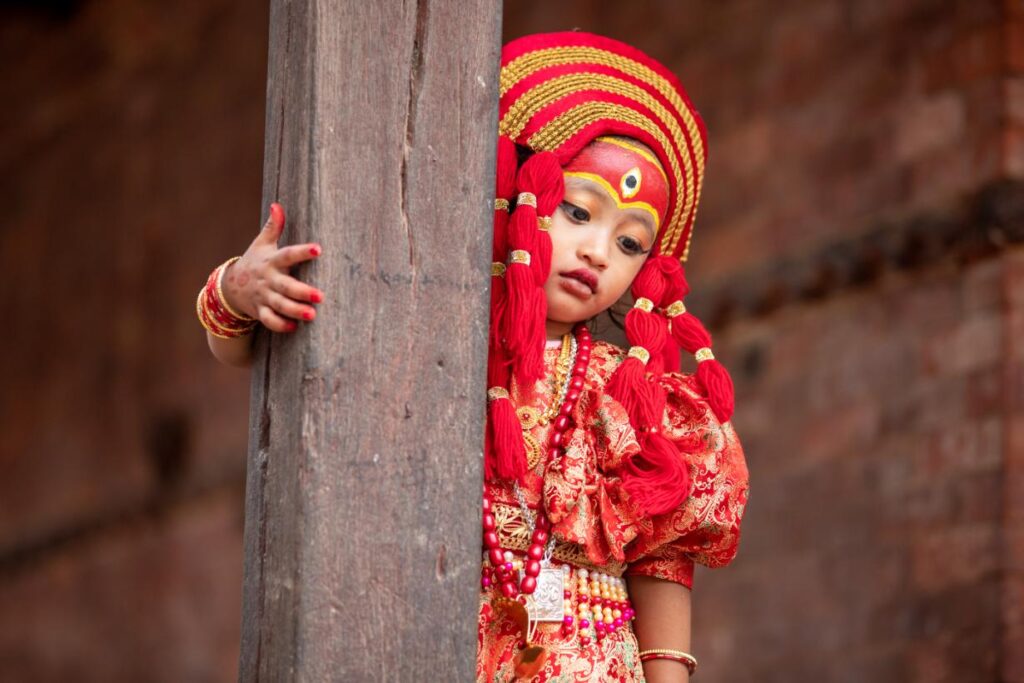
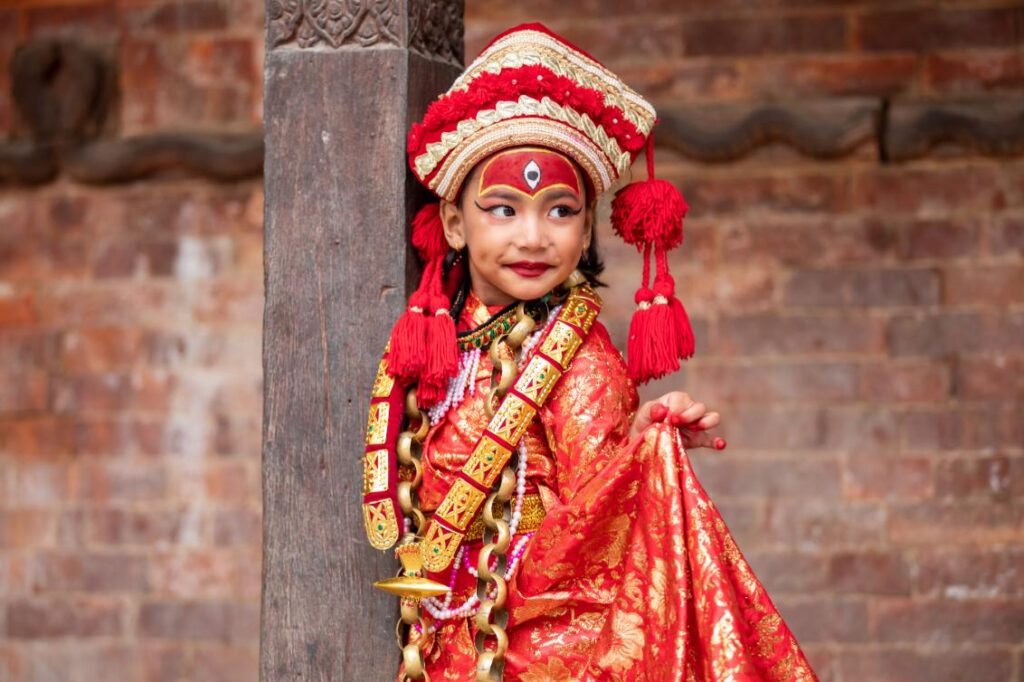
The girl who passes all these showing courage in the middle of the dancing and sacrificed animal heads is selected then as the next Kumari, the reincarnation of Goddess Taleju. She is then taken for the necessary ritual that involves cleansing her past life and welcoming the new and isolated life of Kumari, the living Goddess. Although today, most Kumari get to see their families and the family members can live with them.
The Kumari House: Life of the Royal Kumari
The Kumari of Kathmandu are the most popular and with this fame, she has more rules to follow and boundaries set than other Kumaris. Due to some necessary changes in the society, Kathmandu’s Kumari can at least now welcome her family members on formal occasions which is like 13 times a year. However, the family members aren’t allowed to live with her contrary to the rules of other Kumaris.
Formal education is provided to her by her caretakers in the Kumari house itself. The Kumari house is an old palace building with minimal facilities and comfort of the modern world. The Kumari spend their days in a 4-wall room lit fairly with candles and lamps. Regardless of the respect, the title of a Goddess, and privileges, it is not so easy being a Kumari. Being selected as the only living goddess in the world comes with great dedication and sacrifices.
Many royalties and big names in politics still visit the Royal Kumari seeking her blessings. Many seek for Kumari’s blessings for getting rid of blood and menstruation problems as well.
Shakti (power) of Kumari
In Nepal, the Hindu Buddhist community considers Kumari as the goddess of Shakti (power), as she is the living incarnation of the Taleju Bhawani and Durga. Devi is regarded as being above all others, as people believe it is the power of the goddess that brings everything into being and makes it live. There is nothing without the power of the goddess; that’s why people worship Kumari, as they believe the power is in her pure and living form. Unlike the male gods, Kumari has a separate identity and set of attributes.
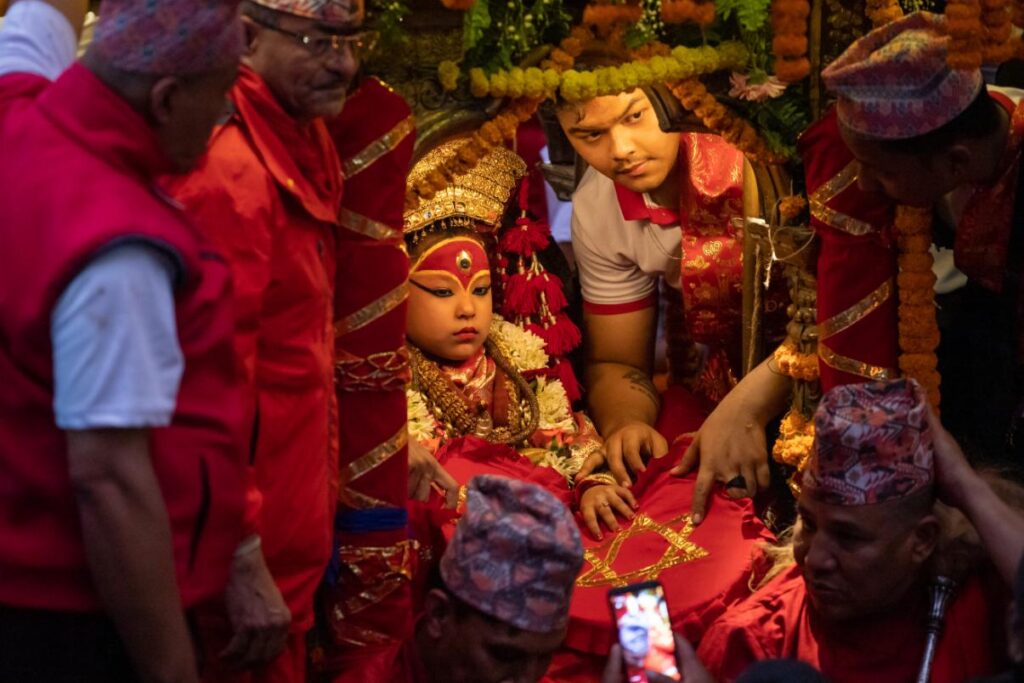
The living goddess is one such manifestation and a particularly powerful one since she materializes in the human incarnation. On normal days, people worship in a simple manner. The audience room is on the second floor of the Kumari Ghar, with the golden throne, and the King worships her through the golden window overlooking the Durbar Square. All powerful pujas take place in the Kumari Ghar, whereas the special, deeper practices of Kumari the Living Goddess worship are kept secret from everyone, even the local Newars.
Life after being chosen as Kumari
After being chosen as a Kumari, she has to follow different rules and regulations, like having to be a serious-looking girl with very little body movement. She is not allowed to touch the ground except in the place she is worshiped, as she is considered the living incarnation of the goddess, and the land is also considered to be god. So, Kumari (as a goddess) is not allowed to touch another god. Kumari Devi is carried by the caretaker or in a palanquin.
Blood is very important to the Kumari because it is thought to hold the goddess Durga’s creative energy, called Shakti. But, as Kumari Devi is half Hindu and half Buddhist, she is not allowed to see the sacrifice, and the animal’s sacrifice should be carried out before she arrives at the goddess inside her. The main reasons behind this were pollution, and she couldn’t even bleed herself because the blood could contaminate the shakti of the goddess inside her. All her blood has to remain inside her body; not even a drop should be spoiled. Although Kumari Devi is a child, she has all the potential of a woman.
The Third Eye of Kumari
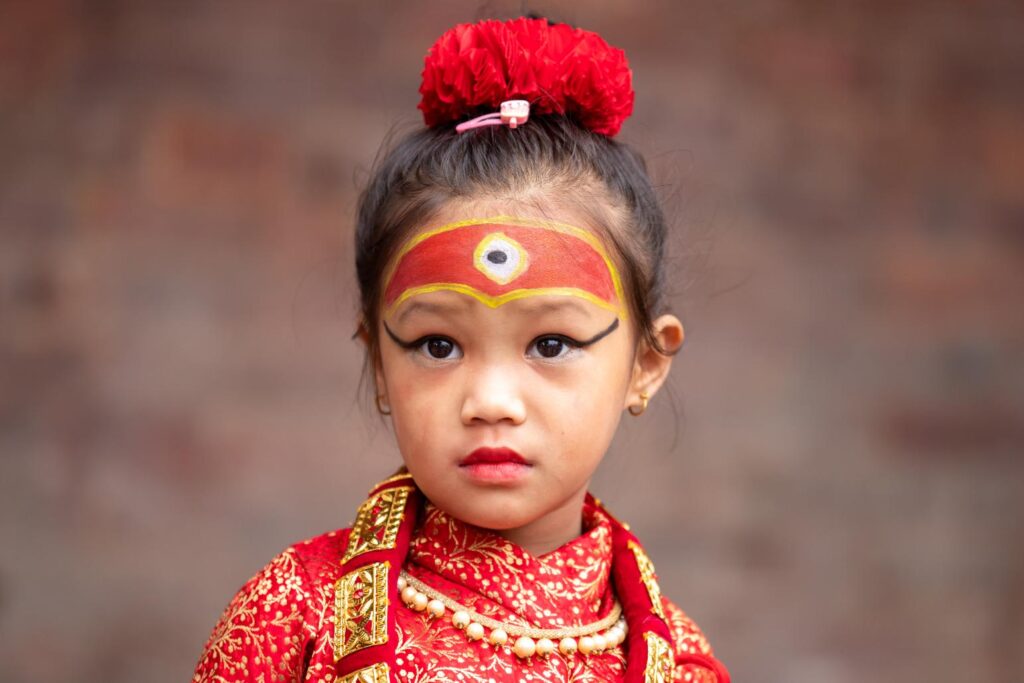
People around the world have a spiritual and holistic belief in the “fire eye” or “third eye,” located in the sacred spots on the forehead. It is said that a fire-eye can make someone happy or turn someone into a pile of burning ashes. Kumari wears the “third eye,” the dristi (a golden eye with a black pupil), only during Dashain or Indra Jatra, when she is regarded as being as powerful as she can get. It is said to open the channels of communication between Kumari Devi and the goddess. It is said to have a powerful connection with the goddess if they communicate through the third eye.
Life-deciding gestures of Kumari
Kumari is supposed to be serious-looking while a goddess but can smile and live a normal life when not being worshiped. There are different signs Kumari shows when she makes predictions about you:
– Crying/Louder Laugh: Severe Illness or death
– Picking at food offerings: financial losses
– Hand Clapping: Reason to fear the king
– Weeping or rubbing eyes: imminent death or last days
– Trembling: Imprisonment
How does the reign of the living Goddess come to an end?
A Kumari is an embodiment of pureness and power. Her pre-pubescent age is a criterion for selection as the Kumari and she shouldn’t have lost a drop of blood. As soon as she comes to an age of adolescence and experiences her first menstruation, she is considered impure and is dethroned from the title of Kumari. And thus, the search for a new Kumari commences.
Untimely dethroning is possible if there’s any cut that results in loss of blood from the body. In such cases, the Kumari is considered to become a normal human and hence loses the power of the Goddess.
After her time as a Kumari , she is given back to her parents or guardians to live a normal life, far different from what she was familiar with. After leaving the position, Kumaris are given a token pension. This transition can be hard on some girls who have lived all their lives as a living Goddess and now are going to a quite unknown and unpredictable life.
Himalayan Trekking can arrange a visit to the Kumari House at Basantapur according to your planning and timings here in Kathmandu. We can tailor any of our Nepal Tour Packages to meet your requirements and plan accordingly. Although it might be close to impossible to get even a glimpse of the living Goddess Kumari, you can take a walk around the house and witness its traditional architecture with the guide telling you fascinating stories and facts about its history.
Get in touch using contact no: +977-9851032316 and get more information about how you can proceed with a tour of Basantapur Durbar Square and the Kumari House.
You may also like:
Send an Enquiry
© 2024 - Himalayan Trekking and Tours (P) Ltd. All Rights Reserved.


